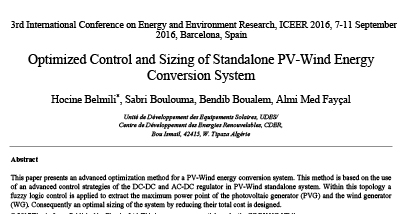Current researches are focused on the electrical production using multi-sources energy conversion systems. Photovoltaic generators (PVG) have maximum power points (MPP) corresponding to meteorological conditions. cell area and load. In Wind generator (WG) when the wind speed varies considerably. the variable speed generation (VSG) is more noticeable than fixed speed systems. In these systems. a maximum power point tracking (MPPT) adjusts the system’s quantity to maximize turbine power output. In PV-Wind stand-alone systems. MPPT algorithms are usually implemented on both DC-DC and AC-DC converters. while battery banks are required to store surplus energy. as shown in Fig.1. MPPT methods can be classified into conventional and advanced methods. The conventional methods. require a prior knowledge of the characteristic of the system. or are based on mathematical relationship which does not meet all meteorological conditions. Therefore. they cannot precisely track the MPP of PV generator or the Wind generator at any at any meteorological conditions. Intelligent MPPT methods (i.e. fuzzy logic (FL) and artificial neural networks (ANN) are more efficient. but they are more complex compared to the conventional techniques that are generally simple. cheap and less efficient.

 Iran Energy News Oil, Gas, Petrochemical and Energy Field Specialized Channel
Iran Energy News Oil, Gas, Petrochemical and Energy Field Specialized Channel



